|
|
|
Story 8
The Bullets of Kellys Creek
|
Were they “The bullets of the rush to get away”?
Bill Denheld
ON THAT FATEFUL Saturday, 26 Oct. 1878 after the shooting of the
three policemen at Stringybark Creek towards dusk, the Kelly gang
departed from the scene loaded with the captured firearms,
ammunition and provisions to ensure their survival. With bulging
pockets and all they could carry on the way back to their hut, and
in the rush to get away, they would not have noticed some dropped
bullets along the way. (Conjecture! maybe, but something like this
certainly could have happened).
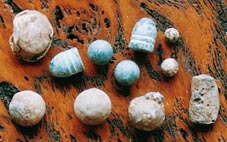
When I found the bullets back in 1985 I knew they could be
important. I also knew there could be much conjecture as to their
authenticity and association with the Kelly’s. The bullets came from
the very place where Ned and Dan lived and worked in hiding and from where
they took off as the Kelly Gang.
Picture: Central.0.45 inch Calibre
bullets and balls, upper right, 0.31 revolver ball bullet. Lower, .65 Cal.
balls for muzzle and
breech loading cartridge shot guns. Upper left, impacted ball, all
found at Kellys Ck.
It is recorded that Ned Kelly, after he had shot Const. Lonigan, had
taken Kennedy's
double barrel shotgun from out of the tent and emptied out several cartridges and
replaced the shot with solid balls like these pictured. When Kennedy
and Scanlon returned to camp, they engaged in the gunfight using
their .45 Cal. Webley revolvers and were either wounded or killed
with the balls loaded into that shotgun. It is not known if the
police provisions included musket balls or that Ned Kelly himself
produced these. The Kelly gang
were now armed with the 4 Webley revolvers, a double barrel shot gun
and a powerful Spencer rifle .50 Calibre and ammunition.
Of all the places where the Kelly saga was to unfold, none could be
considered today as still pristine - except for the Wombat Ranges
table lands interior and in particular - Kelly’s Creek ( then known
as Bullock Creek) near Tolmie Victoria. Its low population
proximity, its isolation and a heap of old saw dust left behind from
an old sawmill, ensured this place remained unchanged virtually
without the influences of what 125 years of settlement may have
done. Adjoining this site however, farms sprang up from around the
early 1900's but were closed off in 1947 when the state water board
acquired all surrounding farms on the table lands to ensure pure
water for nearby City of Benalla
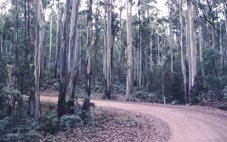 Pristine
forest at Kelly’s Creek on the Tatong road. Although few of the
original big old trees remain, not much has changed around here.
This corner is at Kellys creek heading south . Pristine
forest at Kelly’s Creek on the Tatong road. Although few of the
original big old trees remain, not much has changed around here.
This corner is at Kellys creek heading south .
We found out about this place when we purchased Keith
McMenomy’s fabulous book Ned Kelly,
The Authentic Illustrated Story. In it is a picture of an 1884
survey map of the area. By foot and using hand held compass, we
bashed our way into the area, only to find a huge pile of saw dust
near where we thought the Kelly Hut would have been. A sawmill had
occupied the Kelly camp years before.
Only a handful of people who live/d around these parts knew exactly
where this place was and of its significance to the Kelly story. For
more than a hundred years Kellys Creek had been almost forgotten and
hard to find much as it was at the start of colonization.
|
 When
the Kelly brothers first came here early 1878, there was already
an abandoned prospectors hut,
there was a running spring and a perfect natural basin to retain
strayed cattle and horses ‘found before they got lost’. After
fixing up the hut, Dan and younger brother Jim, began to work
the alluvial gold diggings a little further down the creek. Home
away from home and nobody knew they were there. The nearest
farmer was six miles away and be none the wiser about activities
at Bullock Creek. (Picture, reportedly taken by photographer 'Stewart' of Bourke Street. Courtesy of Keith
McMenomy's book,
Ned Kelly, The authentic illustrated story. ). When
the Kelly brothers first came here early 1878, there was already
an abandoned prospectors hut,
there was a running spring and a perfect natural basin to retain
strayed cattle and horses ‘found before they got lost’. After
fixing up the hut, Dan and younger brother Jim, began to work
the alluvial gold diggings a little further down the creek. Home
away from home and nobody knew they were there. The nearest
farmer was six miles away and be none the wiser about activities
at Bullock Creek. (Picture, reportedly taken by photographer 'Stewart' of Bourke Street. Courtesy of Keith
McMenomy's book,
Ned Kelly, The authentic illustrated story. ).
Note, to read about this hut see story 9 |
We can wonder what influence a hide out like this would have on the
brothers’ antics, where you could hide stolen cattle, they
themselves were able to disappear without trace and only those who
knew their where abouts could bring in provisions. While in trouble
and wanted by the police and fearing the worst, it was from here
that Ned and Dan learned to shoot straight, for it was recorded in a
letter written by Constable / Supt. Frank James
dated Sunday 24th Nov 1878 to
Supt. Sadleir who had requested information on finding the Bullock
Ck hut of the Kelly's,
James wrote;
| |
On examining the trees within range of the loopholed hut we
found that they had been used as targets for rifle-
practice, hundreds of bullets having been fired into them and
then cut out... |
|
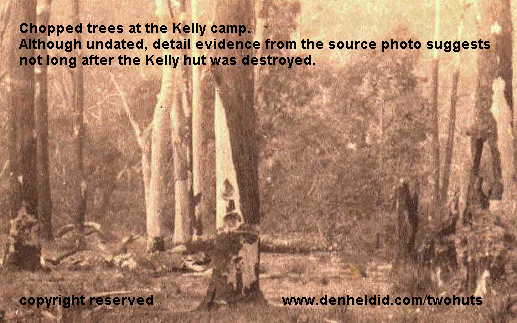
Note: The above 'left and central' ringbarked and chopped trees were identified August 2003. This was a thrilling find as I knew nobody had actually seen these details for what they were, as described and reported by Constable Frank James Nov 1878. This picture is looking North easterly late afternoon, and is un-refutable evidence of lead chopping from fully grown ringbarked trees close to the Kelly camp hut site, this casts doubt on the notion that the other photograph of the Kelly hut of 1880, can have been of the same hut and place. We know from an extremely reliable source that this was the Kelly camp on Bullock Ck.
With great interest, as reported in The Argus Saturday November 13th
1880, (quite some time after the shootings
at Stringybark Creek), the reporter wrote a lengthy article on his
visit to Kelly haunts. of the Kelly camp that he visited he wrote,
in
every direction- taking the hut as a standing point we saw trees
which were marked with bullet holes, from five to fifty having
been fired into each, at ranges varying from 20 to 400 yards. The
bullets being afterwards chopped out, were melted down, and
converted again into their former state.
On one small tree a circle of charcoal 6 inches in diameter had
been traced and into this two or three revolver bullets
had been
fired one striking the black dot meant to represent the bulls eye
in the centre, and the other two being close to it. Some
of the bullets had gone to a depth of four inches in the trees,
and consequently a great deal of chopping had to be done to get
them out, and there was abundant evidence, too, to prove that the
more practice the outlaws had, the more they improved in the use
of the rifle and revolver, the shooting at some marks on the trees
being very wide. and on others remarkable straight and dead into
the bulls eye.
From the reporters description above, indicates the Kelly's had a
revolver as he notes targets six inches in diameter into which two
or three revolver bullets had been fired. I am sure the reporter would have
known the difference between a large finger sized hole of a .577 inch calibre rifle bullet
impact compared to a pee sized revolver bullet hole. There is no proof Kelly
had a revolver other than from statements made by Const. McIntyre after the
killings at Stringybark. McIntyre stated that immediately after
Kelly shot Lonigan
with his sawn-off carbine*,
he whipped out a pistol which he tossed to his other hand to replace
the now useless rifle. * (an old Crimean war relic of 1853 made by
Enfield)
At the siege at Glenrowan some 20 months later. 'Ned Kelly' had a ‘Pocket
Colt’ of .31 inch calibre which is considered by historians, Ned
had at Stringybark Creek and thus at Bullock Ck.
Having found at least one pee size .31 ball at the Kelly Ck site ,
this could be compelling proof to suggest that the Kellys had a pocket
colt weapon there. While the site could reveal many more bullet
finds in the future, non so far can positively be connected to the
Kellys. What is sure by all historical reports is they fired lots of
rounds at targets around the hut, However , of
great interest to me was what had happened to the lead that missed
its targets. This is what attracted me to investigate and
‘metal detect’ for the bullets of Kelly’s Creek for
where else could one find a Kelly related relic?
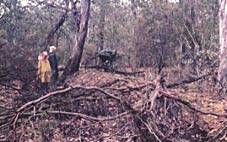 Here
we are detecting at Kelly’s Creek 1985 with family looking
on. Since then, the place has become infested with blackberries
so much you can barely walk here. Here
we are detecting at Kelly’s Creek 1985 with family looking
on. Since then, the place has become infested with blackberries
so much you can barely walk here.
During
our first family visit I found the undergrowth fairly open for detecting.
Many - many items were found, of mostly what you would expect to
find - rusty bits of old metal left behind by prospectors and saw
millers. There are lumps of old cast iron, hand made nails, brass
trouser buttons, rusted bits of wire, even the rotted remains of
boots or shoes detected by the rusty halo left in the ground by
the long gone shoe tacks, but no rubbish of modern times.
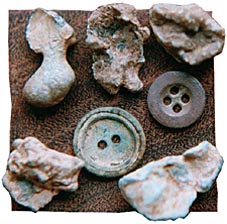
Splattered
lead.
Each of these pieces represent a projectile fired from a gun.
On hitting a tree or hard ground the bullets splat into pieces and
those left above ground level are sometimes melted when a bush fire
goes through the area.
Note-top left melted bullet
after bush fires. |
|
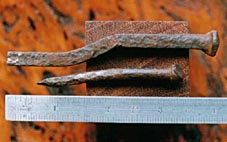 Top:
Four inch hand forged nail. Bottom: machine made nail, bearing hammer
mark on head. There are numerous nails like the lower one at the
site and date from 1930’s but the top nail is much earlier
and hand forged. Top:
Four inch hand forged nail. Bottom: machine made nail, bearing hammer
mark on head. There are numerous nails like the lower one at the
site and date from 1930’s but the top nail is much earlier
and hand forged.
Skirting around, away from where I knew the hut had stood, I spent
many hours detecting in the direction of the imaginary line of fire
for bullet shots that had missed the target. I considered
eventually I would have to find something. After detecting hundreds
of signals, I was rewarded with a lead slug, some Muscat balls, and
one in particular a .31 inch diameter ball of the type that could
have been fired from Ned’s Pocket Colt. Finding this was considered
very significant, although at the time I was not aware exactly what
guns the Kellys actually had.
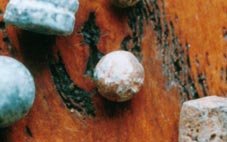 Bullet
ball 0.31 calibre. Could this have been fired from Ned’s Pocket
Colt? Bullet
ball 0.31 calibre. Could this have been fired from Ned’s Pocket
Colt?
The pee size pellet looks like it has been fired as it is slightly
impacted out of shape.
|
|
|
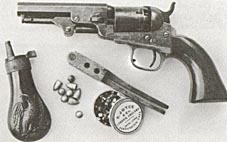 Pocket
Colt 0.31 calibre with accessories. Showing powder flask, bullet
mould with moulded projectiles - both ball and conical, and a tin
of percussion caps. Ned had one just like this but with a longer
barrel. This picture from the book “Tracking Down Bushrangers”
by Peter C. Smith, by Kangaroo Press 1982. Pocket
Colt 0.31 calibre with accessories. Showing powder flask, bullet
mould with moulded projectiles - both ball and conical, and a tin
of percussion caps. Ned had one just like this but with a longer
barrel. This picture from the book “Tracking Down Bushrangers”
by Peter C. Smith, by Kangaroo Press 1982.
Not
being sure about private property boundaries, there are no fences
to cross, plus not being convinced about the exact location of the
hut, and with a friend who has an aeroplane, we flew over the place.
Pictures were taken from the air and local parish plans were obtained
to overlay the aerial pictures to check for private property boundaries
in the area and the exact location of the hut was reconfirmed. All
detecting was done on ‘crown land’. No permission was
required to be there and if I were detecting for gold, I was doing
so with a current Miners Right.
 View
of Kelly’s Creek flying over Wombat State Forest. The deep
impression at the head of the gully is the saw dust heap where the
hut was located. The plotted lines of 21A has the saw dust heap
inside the boundary on private property, but on the Parish plan
below has is outside the boundary on crown land which I believe
may be wrong. The hut was plotted by surveyors pre 1900’s
yet very accurate. View
of Kelly’s Creek flying over Wombat State Forest. The deep
impression at the head of the gully is the saw dust heap where the
hut was located. The plotted lines of 21A has the saw dust heap
inside the boundary on private property, but on the Parish plan
below has is outside the boundary on crown land which I believe
may be wrong. The hut was plotted by surveyors pre 1900’s
yet very accurate.
On
a return visit several months later, I decided to head out some
distance from the huts estimated location, in a general North easterly
direction, when I came across a find that took me by surprise. Here
in a small area, I found two conical shaped bullets and two round
balls, generally in a group. They measure .45 inch unfired.
When
the detector sounded, I kicked the surface litter away with my boot,
hoping to move the detected metal targets, instead there was still
solid soil beneath and the metal was still there. With ‘pick-shovel’
I scraped down to unearth the first bullet. It was imbedded in the
soil strata and not just lying on the ground, it was well under
the surface. Obviously the bullets had been there a long time and
protected from bush fires by the accumulated surface soil and had
not been melted by fires. All four bullets were found at similar
depth, and in a manner you would expect if left undisturbed for
over 100 years. The bullets were found on a slight ridge between
Kelly’s Creek and Stringybark Creek and away from boggy low
ground.
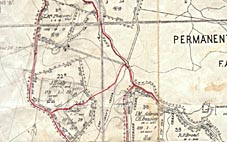 Parish
plan: This copy shows the Parish Plan dated around 1902.
It shows the relationship between Kelly’s Creek and Stringybark
Creek with German Creek in between. It was on the North side of
German Creek where they found Sergeant Kennedy’s body. The
‘contour’ lines are pencilled in on this parish plan
by myself and I believe the contour indicates the easiest path for
the gang to get back to the hut. Note: Compass North at bottom left. Parish
plan: This copy shows the Parish Plan dated around 1902.
It shows the relationship between Kelly’s Creek and Stringybark
Creek with German Creek in between. It was on the North side of
German Creek where they found Sergeant Kennedy’s body. The
‘contour’ lines are pencilled in on this parish plan
by myself and I believe the contour indicates the easiest path for
the gang to get back to the hut. Note: Compass North at bottom left.
Supt. Frank
James
Horse tracks leading away from the murder scene were found by
blacktrackers under command of Supt. James some time later - they crossed through the swampy reeds - to the
other side of the creek, in a general northerly direction. My belief is that
the gang would instinctively have known the direction to their hut
- North West, but by following the Creek North,
they would veer left to cross German Creek near where Sergeant Kennedy’s
body lay, (maybe in the hope to find his dropped weapon), then they would veer left again
following the land contours up into their little valley to the hut
and in doing so approached the hut facing West. (The Webley revolver
was found near where Sergeant Kennedy's body was found by the
search party several days later).
To
qualify my claim that these bullets could be associated with the
Kelly’s, I would like to make the following points,
Only
one other
I became a gold prospector and miner from 1979 to 1984,
using metal detectors and machinery throughout the Victorian gold
fields. In that four and a half year period I have dug up many thousands
of items of interest, and during that time, I have only ever found
one other cone bullet of .45 calibre, so I knew
the significance of my find at Kelly’s Creek. Having had this
vital experience and knowing what to expect in the gold fields,
I feel I am in a position to qualify my claim that what I have found
is important and most certainly associated with the Kelly’s.
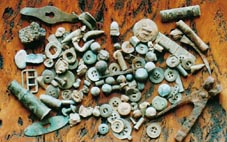 Central
top: Conical .45 calibre bullet is the only other I have ever found. It has been fired, I found this at Dunolly, Victoria
1980. This picture shows a range of interesting items collected
from thousands of detections throughout the Victorian Gold fields. Central
top: Conical .45 calibre bullet is the only other I have ever found. It has been fired, I found this at Dunolly, Victoria
1980. This picture shows a range of interesting items collected
from thousands of detections throughout the Victorian Gold fields.
Note 9 other Musket balls ,splattered lead, a large shell case and
bullet along side. The pliers (right) is actually a bullet mould
for estimate .38 calibre ball found at Wedderburn, Victoria.
.45
Cone bullets not common for hunting in 1878
Hardly anyone at that time would have had military firearms for
normal hunting use. The most common firearm of the day was the muzzle
loading shot gun (fowling piece) but they could also fire a solid
slug or musket ball. Cone bullets of .45 calibre are associated
with higher velocity military type rifles or revolvers and are intended
to be used to kill people. Most common firearms were percussion
type where a small percussion cap was placed over a nipple and the
bullet and powder fed down the barrel from the muzzle end.
The calibre of these old weapons ranged from .52 to .758 but it was
not until 1869 that due to experiments by Whitworth that .45 became
a considered best calibre for military use. This trend lasted only
10 years and by 1880 was replaced by smaller calibres. My suggestion
that .45 was not common at the time that the Kellys were at Bullock
creek holds true since weapons manufactures like Martini Henry
,Remington, Springfield and Spencer, all breech loading, adopted .45
during that ten year period, and then slowly became available and favoured by hunters and
kangaroo shooters because the bullets were cased. However, there
were many manufactures making .45 Cal. revolver hand guns during
this period. Taking a look at the picture above, shows a only one
.45 bullet amongst a dozen or so large ball projectiles found at
goldfields over a four year plus period.
Hard
times
It is known that a certain number of saw millers lived in the vicinity,
it could be argued that saw millers had dropped the .45 Cal. bullets, but
how many poor millers would have had military type weapons for game
shooting, while even Ned himself could only lay his hands on a buggered
old 1850’s muzzle loading carbine? It would be unlikely that
the 50 years between the Kellys and the Sawmill in 1930 would suddenly
see a whole lot of shooting with high powered .45 calibre rifles
in the area. In fact, times were tougher for the average battler
in country Victoria in the early 1900’s, than the end of the
previous century.
Webley
.45 revolvers the police used were actually .442 caliber
bore Webley Royal Irish Constabulary (RIC) No1 issue. These Webleys
as issued to the police and would have
been favoured by the Kelly gang, as they used ready made cartridges
for immediate use. It
was recorded that the gang took all the Webley guns after the murders,
as well as a ‘Spencer rifle. Perhaps included with the captured
firearms, was a reloading kit, consisting of cartridges, powder
and loose bullets for the Webleys, if not also for the Spencer rifle.
I
like to believe the .45 bullets were associated with the Police.
The
unfired bullets were found on a general line of contour between
Stringybark Creek and the Kelly Creek hut -
but closer to the hut. See map above.
Conjecture:
were they The bullets of the rush to get away?
On that fateful Saturday 26 October 1887 after the shooting of the
three policemen at Stringybark Creek towards dusk, the gang departed
from the scene loaded with the captured firearms, ammunition and
provisions to ensure their survival. With bulging pockets on the
way back to their hut close by, and ‘in the rush to get away,’
they would not have noticed some dropped bullets along the way.
Were these the bullets I found?
Conjecture:
were they dropped by Constable James?
While we may never know the true story of how the bullets came to
be there, eminent historian Mr Ian Jones, author of Ned Kelly
A Short Life pointed out that they could have belonged to Constable
James who followed the gangs tracks that lead to the hut at Bullock
Creek. Constable James had a ‘Tranter’ hand gun that
used loose .45 calibre bullets and balls of the type I found.
All opinions and conjecture are open to comment, please
feel free to email
me your thoughts.
The
following short story is about a man whose father was there (at
Kelly’s Creek and Hut). And I met that man by sheer coincidence:
Local
identity Mr. Billy Stewart of Mansfield had known
of this special place but had kept it secret for most
of his life telling only close friends about it. By amazing coincidence
I met Billy in September 1985 six months after we had found the
bullets, He had been the neighbour of a Mr Kevin Shanks in Mansfield
till Mr Shanks moved to Croydon, Victoria - and became my neighbour
in 1978. On telling Kevin about our interest in the Kelly’s
and of our found bullets, he introduced us to Billy Stewart.
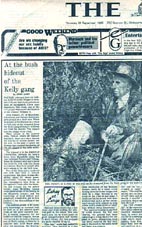 Bill Stewart, aged 81 in 1985, told us he recalls when, as a child, he
was taken to the Kelly hut by his father as early as 1909. Years
later Billy remembers his father would surprise accompanying visitors
to the Kelly hut site, by trying to axe out some bullets from
an old dead tree standing nearby and then producing a slug, stating
it was Kelly lead, but Billy wryly smiled at us indicating the
lead was pulled from his pocket tricking the visitors to believe
it was real. That tree stood for many years even
while the sawmill was in operation and was known as the Kelly
target
tree. It was lying rotting, barely visible in the boggy
creek just below from where it stood. Around
1930, Bill was employed by the Mc Cashneys and helped build
the sawmill directly over where the Kelly camp and hut had stood. Billy
said the four corner posts were still standing when he was a boy. The sawmill ceased
operation during the depression (mid 1930's) with little to show
for the effort except a huge
pile of rotted down saw dust.
Bill Stewart, aged 81 in 1985, told us he recalls when, as a child, he
was taken to the Kelly hut by his father as early as 1909. Years
later Billy remembers his father would surprise accompanying visitors
to the Kelly hut site, by trying to axe out some bullets from
an old dead tree standing nearby and then producing a slug, stating
it was Kelly lead, but Billy wryly smiled at us indicating the
lead was pulled from his pocket tricking the visitors to believe
it was real. That tree stood for many years even
while the sawmill was in operation and was known as the Kelly
target
tree. It was lying rotting, barely visible in the boggy
creek just below from where it stood. Around
1930, Bill was employed by the Mc Cashneys and helped build
the sawmill directly over where the Kelly camp and hut had stood. Billy
said the four corner posts were still standing when he was a boy. The sawmill ceased
operation during the depression (mid 1930's) with little to show
for the effort except a huge
pile of rotted down saw dust.
When
I contacted Billy he was keen to show me everything he knew for
which we were very grateful but this had been his ‘protected
secret’ for most of his life and six months later Billy
decided to announce his secret to The Age newspaper dated
26 September 1985 and the full story of the Kelly hideout and
location was revealed on the front page. Writer and historian
Mr John Lahey wrote that when Billy was a child playing at the
hideout he was only as far removed from the Kelly’s as today’s
children are from the Beatles era.
One
hundred and five years earlier, the Kelly hut had been reported
in The Age and Argus news paper only days after the gang members were declared
outlaws. Sometime
after Ned’s capture and hanging, Bullock Creek was re named
Kelly’s Creek by the local shire.
Perhaps
due to the complacency of local authorities at the time, it was
hoped the whole saga would go away and that this place be forgotten
- as it virtually has been, but the story never went away, for
the police increased their presence in most northern Victorian
towns and districts fearing uprisings from Kelly sympathisers
who may push further for Ned’s proclamation for a republic
in North East Victoria. The police actually went on Kelly sympathiser
witch hunts to weed out potential trouble. They
wanted people to DOB in on people. The results of which divided
families and whole communities to this day.
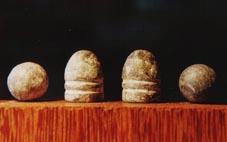 The bullets of Kelly's Creek were found by Bill Denheld using a metal detector in April of 1985. Musket balls of various sizes from .3 calibre to .65 Cal. were found that may have been fired from the weapons the Kellys had while practicing his marksmanship at Bullock Creek. The bullets (right) are .45 calibre and were found in a general line between Kelly's Creek and Stringybark Creek - but closer to Kelly's Creek on crown land. The bullets of Kelly's Creek were found by Bill Denheld using a metal detector in April of 1985. Musket balls of various sizes from .3 calibre to .65 Cal. were found that may have been fired from the weapons the Kellys had while practicing his marksmanship at Bullock Creek. The bullets (right) are .45 calibre and were found in a general line between Kelly's Creek and Stringybark Creek - but closer to Kelly's Creek on crown land.
The Kelly's Creek area has escaped development and is still close to its original state as only a hand full of people knew exactly where it was right up to the present day. It is an almost untouched area due to its isolation and kept secret. It is unlikely these bullets could have been associated with the weapons that the gang took from the police camp after the killings at Stringybark Creek as the .45 Cal Webley s used fully cased bullets. The Spencer rifle used .5 Cal bullets and brass cased. Most likely, the loose bullets are of the type used in revolvers. How they came to be where I found them remains a mystery.
The author makes no claims any of the items displayed are Kelly relics. What is clear however, is the fact that in comparison to any other place he has metal detected,- through out the Victorian gold fields, this area turns up a lot of bullet lead. With virtually no farming land use in its history, it is fair to assume a lot of that bullet lead is Kelly related.
Bill Denheld email bill at denheldid dot com
Site posted 1/8/02 refreshed 28/4/03
Copyright
,, no text or images may be reproduced without
written permission from the author Bill Denheld. Copyright
|
|

 Pristine
forest at Kelly’s Creek on the Tatong road. Although few of the
original big old trees remain, not much has changed around here.
This corner is at Kellys creek heading south .
Pristine
forest at Kelly’s Creek on the Tatong road. Although few of the
original big old trees remain, not much has changed around here.
This corner is at Kellys creek heading south . When
the Kelly brothers first came here early 1878, there was already
an abandoned prospectors hut,
there was a running spring and a perfect natural basin to retain
strayed cattle and horses ‘found before they got lost’. After
fixing up the hut, Dan and younger brother Jim, began to work
the alluvial gold diggings a little further down the creek. Home
away from home and nobody knew they were there. The nearest
farmer was six miles away and be none the wiser about activities
at Bullock Creek. (Picture, reportedly taken by photographer 'Stewart' of Bourke Street. Courtesy of Keith
McMenomy's book,
Ned Kelly, The authentic illustrated story. ).
When
the Kelly brothers first came here early 1878, there was already
an abandoned prospectors hut,
there was a running spring and a perfect natural basin to retain
strayed cattle and horses ‘found before they got lost’. After
fixing up the hut, Dan and younger brother Jim, began to work
the alluvial gold diggings a little further down the creek. Home
away from home and nobody knew they were there. The nearest
farmer was six miles away and be none the wiser about activities
at Bullock Creek. (Picture, reportedly taken by photographer 'Stewart' of Bourke Street. Courtesy of Keith
McMenomy's book,
Ned Kelly, The authentic illustrated story. ).
 Here
we are detecting at Kelly’s Creek 1985 with family looking
on. Since then, the place has become infested with blackberries
so much you can barely walk here.
Here
we are detecting at Kelly’s Creek 1985 with family looking
on. Since then, the place has become infested with blackberries
so much you can barely walk here.
 Top:
Four inch hand forged nail. Bottom: machine made nail, bearing hammer
mark on head. There are numerous nails like the lower one at the
site and date from 1930’s but the top nail is much earlier
and hand forged.
Top:
Four inch hand forged nail. Bottom: machine made nail, bearing hammer
mark on head. There are numerous nails like the lower one at the
site and date from 1930’s but the top nail is much earlier
and hand forged. Bullet
ball 0.31 calibre. Could this have been fired from Ned’s Pocket
Colt?
Bullet
ball 0.31 calibre. Could this have been fired from Ned’s Pocket
Colt? Pocket
Colt 0.31 calibre with accessories. Showing powder flask, bullet
mould with moulded projectiles - both ball and conical, and a tin
of percussion caps. Ned had one just like this but with a longer
barrel. This picture from the book “Tracking Down Bushrangers”
by Peter C. Smith, by Kangaroo Press 1982.
Pocket
Colt 0.31 calibre with accessories. Showing powder flask, bullet
mould with moulded projectiles - both ball and conical, and a tin
of percussion caps. Ned had one just like this but with a longer
barrel. This picture from the book “Tracking Down Bushrangers”
by Peter C. Smith, by Kangaroo Press 1982. View
of Kelly’s Creek flying over Wombat State Forest. The deep
impression at the head of the gully is the saw dust heap where the
hut was located. The plotted lines of 21A has the saw dust heap
inside the boundary on private property, but on the Parish plan
below has is outside the boundary on crown land which I believe
may be wrong. The hut was plotted by surveyors pre 1900’s
yet very accurate.
View
of Kelly’s Creek flying over Wombat State Forest. The deep
impression at the head of the gully is the saw dust heap where the
hut was located. The plotted lines of 21A has the saw dust heap
inside the boundary on private property, but on the Parish plan
below has is outside the boundary on crown land which I believe
may be wrong. The hut was plotted by surveyors pre 1900’s
yet very accurate.  Parish
plan: This copy shows the Parish Plan dated around 1902.
It shows the relationship between Kelly’s Creek and Stringybark
Creek with German Creek in between. It was on the North side of
German Creek where they found Sergeant Kennedy’s body. The
‘contour’ lines are pencilled in on this parish plan
by myself and I believe the contour indicates the easiest path for
the gang to get back to the hut. Note: Compass North at bottom left.
Parish
plan: This copy shows the Parish Plan dated around 1902.
It shows the relationship between Kelly’s Creek and Stringybark
Creek with German Creek in between. It was on the North side of
German Creek where they found Sergeant Kennedy’s body. The
‘contour’ lines are pencilled in on this parish plan
by myself and I believe the contour indicates the easiest path for
the gang to get back to the hut. Note: Compass North at bottom left.
 Central
top: Conical .45 calibre bullet is the only other I have ever found. It has been fired, I found this at Dunolly, Victoria
1980. This picture shows a range of interesting items collected
from thousands of detections throughout the Victorian Gold fields.
Central
top: Conical .45 calibre bullet is the only other I have ever found. It has been fired, I found this at Dunolly, Victoria
1980. This picture shows a range of interesting items collected
from thousands of detections throughout the Victorian Gold fields.
 Bill Stewart, aged 81 in 1985, told us he recalls when, as a child, he
was taken to the Kelly hut by his father as early as 1909. Years
later Billy remembers his father would surprise accompanying visitors
to the Kelly hut site, by trying to axe out some bullets from
an old dead tree standing nearby and then producing a slug, stating
it was Kelly lead, but Billy wryly smiled at us indicating the
lead was pulled from his pocket tricking the visitors to believe
it was real. That tree stood for many years even
while the sawmill was in operation and was known as the Kelly
target
tree. It was lying rotting, barely visible in the boggy
creek just below from where it stood. Around
1930, Bill was employed by the Mc Cashneys and helped build
the sawmill directly over where the Kelly camp and hut had stood. Billy
said the four corner posts were still standing when he was a boy. The sawmill ceased
operation during the depression (mid 1930's) with little to show
for the effort except a huge
pile of rotted down saw dust.
Bill Stewart, aged 81 in 1985, told us he recalls when, as a child, he
was taken to the Kelly hut by his father as early as 1909. Years
later Billy remembers his father would surprise accompanying visitors
to the Kelly hut site, by trying to axe out some bullets from
an old dead tree standing nearby and then producing a slug, stating
it was Kelly lead, but Billy wryly smiled at us indicating the
lead was pulled from his pocket tricking the visitors to believe
it was real. That tree stood for many years even
while the sawmill was in operation and was known as the Kelly
target
tree. It was lying rotting, barely visible in the boggy
creek just below from where it stood. Around
1930, Bill was employed by the Mc Cashneys and helped build
the sawmill directly over where the Kelly camp and hut had stood. Billy
said the four corner posts were still standing when he was a boy. The sawmill ceased
operation during the depression (mid 1930's) with little to show
for the effort except a huge
pile of rotted down saw dust. The bullets of Kelly's Creek were found by Bill Denheld using a metal detector in April of 1985. Musket balls of various sizes from .3 calibre to .65 Cal. were found that may have been fired from the weapons the Kellys had while practicing his marksmanship at Bullock Creek. The bullets (right) are .45 calibre and were found in a general line between Kelly's Creek and Stringybark Creek - but closer to Kelly's Creek on crown land.
The bullets of Kelly's Creek were found by Bill Denheld using a metal detector in April of 1985. Musket balls of various sizes from .3 calibre to .65 Cal. were found that may have been fired from the weapons the Kellys had while practicing his marksmanship at Bullock Creek. The bullets (right) are .45 calibre and were found in a general line between Kelly's Creek and Stringybark Creek - but closer to Kelly's Creek on crown land.